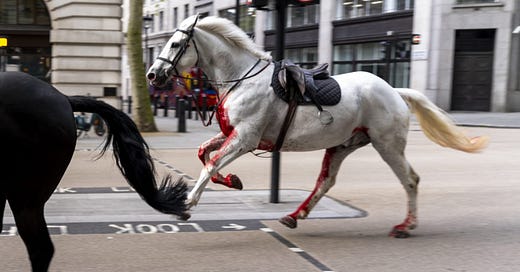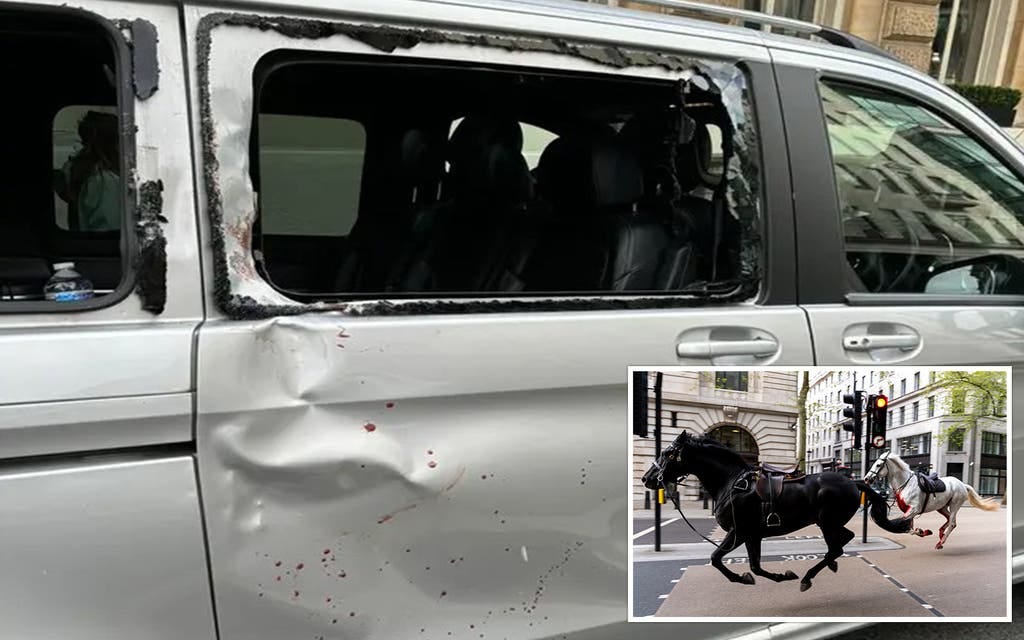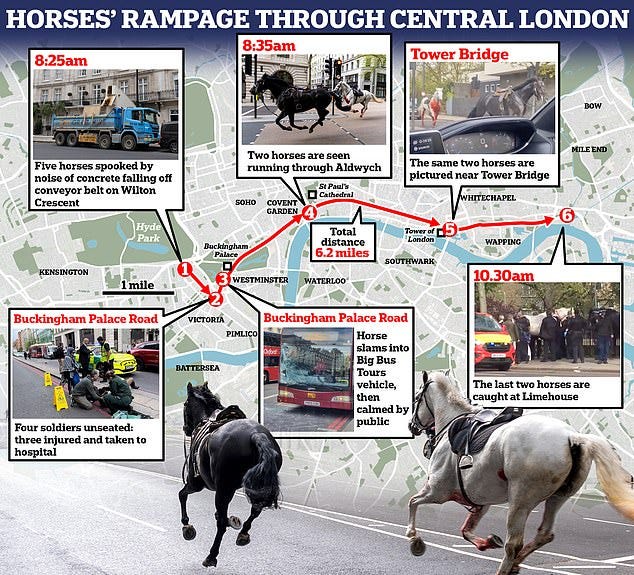Reining Blood - Death Omens in London?
What do blood-soaked horses mean for our collective destiny?
Hnikarr kvað:
“Þat er annat, ef þú ert út of kominn
ok ert á braut búinn, tvá þú lítr
á tái standa hróðrfúsa hali.”
- Reginsmál 21, Elder Edda
The taking of auspice leads us (both the interpreter and the listener) to both joy and woe. This is irrevocably true, whether in the reading of the runes or the observing of bird-flight. Powerful may a wise man become in gaining skill in these things; yet sadness all the same. Hovi counsels us that this sadness is often the case when too wise we seek to become (Hv. 54).
It is with sadness that we, as men seeking that sad wisdom, watched the events unfold in London yesterday. Our English race is one that holds animal welfare to a champion standard, so seeing creatures as sacred as horses in pain and terror is difficult. Even more so for the intricate meaning their blood-soaked flight conveys to the Heathen observer.
I am pleased to say that the horses involved have been secured and are being treated for their injuries. With the closing of this tale, it is opportune that we now take the omens presented and read them; for these are omens, do not doubt that. It is never a good sign to see riderless horses in a rampage, let alone wounded.
Nonetheless - in this essay, we will be analysing the flight of the horses, documenting first the facts as they transpired. We will then compare this to similar events attested in our lore and determine a sufficient answer from this. The personal sacrifices made by our Goðar will be added as an addendum for the benefit of closing our evaluation.
While it may seem redundant to recount these events, when so much of our national journalism has covered it, I would argue it is crucial to do so for that reason. Tabloid media is spurious by its very nature, and often over-embellishes the truth to create climates of hysteria. In light of this, we will rely mainly on the non-partisan equestrian magazine, Horse & Hound, with light reference to the Daily Mail Online.
The central focus will be on the horses (for they are the omen) and, specifically, Vida - the bloodied grey. We will not go into detail on any secondary information (i.e. civilian and soldier injuries) as it is not relevant to deciphering this event. With this clarified, let us investigate the situation…
I. What We Know (For Certain)
On the morning of Wednesday 24th April, seven Life Guards (part of the Household Cavalry) horses were spooked during a regular exercise at Wilton Crescent in Belgravia, London. The noise of local construction work was the cause of the initial upstart, with four of the seven bucking their riders. Five attempted to escape in total, with four successfully loose. (Jones, 24 Apr 20241)
The four horses in flight - Vida, Trojan, Quaker and Tennyson, proceeded to rampage across London for the remainder of the morning. A viral video emerged on X, depicting a pair of the four (Vida, the grey, and Quaker - the black) running loose across a busy street. VIda was seen being chased by Quaker, with the former covered in blood.
The horses were part of three notable accidents during their 6-mile journey. Despite the more visible lacerations seen on VIda (caused by a collision with a minivan near Victoria), it is Quaker who is the more seriously injured of the two (Matthews, 25 April 20242). The pair of them have undergone surgery, with Quaker being subsequently transferred to an equine hospital.
Depicted: blood spatters on the minivan Vida collided with in Victoria, London; 24th April 2024.
The public response to the incident was interesting. One local named Tula saw the two horses, and was quoted as follows:
“I got off the 172 bus which ends at Aldwych and two horses went flying past. One black, one white… The white one was drenched in blood from the chest down and they were galloping through the traffic at speed… People were stopping in the street shocked. The horses were running into fast-moving traffic and seemed terrified. Some unmarked police cars were chasing after them, which didn’t seem to be helping… I felt shocked. It was pretty gruesome. Felt like a weird dream.” (Evans, 24 April 20243)
We will return to this reference to weird dreams, as they are deeply intertwined with Wyrd - and the reading of signs. It is also interesting to point out that this surreal experience is vocalised in such a way by this passerby; assumedly one without good knowledge of auspices, based on our faith’s minority status.
With the facts presented, we can now construct our timeline.
II. A Horse’s Journey
Depicted: Horses’ rampage through Central London - a timeline of the ‘bloodied horse’ incident; 24th April 2024.
The above map provided by the Daily Mail Online helps see the journey taken. It is of significance as it gives us the last key to Vida and Quaker’s journey, with the two of them being depicted at their 10:30AM recapture near Limehouse in Tower Hamlets, London. From our gathered information, the timeline of the pair’s flight is as follows:
8:25AM: Vida and Quaker are among five horses spooked during an exercise (Belgravia, Westminster/Kensington & Chelsea)
8:35AM: Vida and Quaker are pictured running through the street (Aldwych, Westminster) - this is the point seen in the aforementioned video.
8:55AM*-10:30AM: Vida and Quaker are pictured again (Tower Bridge)
10:30AM: The duo is captured and treated, marking the end of their journey (Limehouse, Tower Hamlets)
*This time estimation is liberally based on the time it takes a car to get from Aldwych to Tower Bridge.
This timeline serves as a clear breakdown of the events as and when they transpired. From my observation, it is apparent the horses were in full gallop between Wilton Crescent - Aldwych, covering just over a third of their flight in less than 10 minutes. Their following sightings indicate their gradual slowdown, resulting in their capture over two hours after their escape.
So - what of the signs?
III. Sacred Signs
Many across our faith community have fixated solely on Vida - the blood-soaked grey of our narrative. While we are remiss to entirely ignore the other horses accompanying our friend on his baleful exodus from captivity, I largely concur that he is the most prominent steed we should turn our attention to.
White horses (referred to as greys in the equestrian world) historically are the most sacred colouring there is. Tacitus qualifies this in his work Germania, detailing their significance in both auspice and their uses for the priestly caste:
“To omens and the drawing of lots they pay the very greatest attention […] Peculiar [particular] to the German race is the importance attached to certain forecasts and warnings afforded by horses as well. Horses are kept at the public charges in the sacred woods and groves ; they are white in colour and are never desecrated by any toil in the service of man ; they are harnessed to a sacred car, and the priest and the king or the chief of the state walk beside them and note with the utmost care their neighings and snortings. In no other omen have they firmer faith, and this holds good not only among the common people but also among the chiefs and priests : for these latter, while considering themselves to be the ministers of the gods, think that the sacred steeds are their mouthpieces.” (Townshend, 1894, pp. 624)
We can here see greys used as two-fold: as “mouthpieces” of the Gods, and as temple guardians. Both of these, alongside the statement of their restriction in any “toil in the service of man”, defines the greys of ancient Germania as being the most sacred colouring among steeds. While this does not discount other colourings from sacredness, it does inform that greys were principally so.
It is by the sounds the horses make that signs were interpreted. It is by way of the horse that the words of the Gods were received, with meaning extrapolated by a possible number of ways, including cadence, rhythm, tone, emotion and so on. While Vida is clearly not a temple-horse (nor can we listen to his neighing at length), it is assured he would have been spoken with distress during his flight.
His being a grey is nonetheless a factor to consider, as the colouring was a primary factor in the selection of temple-steeds. It cannot be coincidence, therefore, that his journey was so intertwined with Quaker. As much as they coincide in injury and fear, they contrast in their colouration wildly.
The interaction between light and dark is a common theme recurrent in or hierology. Key amongst these are the heavenly steeds Skinfaxi (English Shining-Maned5) and Hrímfaxi (English Frost-Maned6)7. Hovi speaks of each in Vafþrúðnismál 11-14, in response to the jötunn Vafþrúðnir:
Óðinn said:
12. “That horse is named Skinfaxi;
he pulls the bright sun
over the humans below.
Everyone thinks he’s the best horse
who lives in Midgard—
the mane of that horse always shines.”
14. “That horse is named Hrimfaxi
who pulls the moon, east to west,
every night over the mighty gods.
The slobber from his mouth
falls to the ground every morning,
and that’s the reason for the dew.”
(Crawford, 2015, pp. 51-528)
The specific colouring of their manes as “shining” and “hoarfrost” indicate colourations of golden-white and grey-white respectively. There is no colouring attested for their coats, however, but they are often depicted as white (Skinfaxi) and black (Hrímfaxi) respectively. This is generally agreeable, as it reflects our understanding of day and night - to which these beings represent.
Depicted (left to right): “Dagr” and “Nott” by Peter Nicolai Arbo; 1874. Norwegian painter.
Further reading can be made in this connection of light and dark, such as in the case of Árvakr and Alsviðr - the horses of the chariot of Sunna. There is a very clear undercurrent of horse-chariots being associated to the Sun and, with it, the cycle of day and night, throughout European-derived mythologies (see Phaethon in Hellenic religion). This is another link in the sacred nature of greys in general.
Thus, we see an association of the two in opposition: light and dark, day and night. We lastly look to the most concerning element of the omen - the spattered blood on Vida and Quaker. While not presented as a horse, there is reference in our lore to just such a procession in ancient dream.
The sighting of animals covered in blood is a symbol of death, in almost every context. In Njáls saga, the figure of Þórður sees a bloodied goat. It is apparent that this was the man’s fylgja and, following this, he is killed in a plot. It in referenced in the text that the seeing of this goat-fylgja is an omen of death. (Cook, 20029)
Further example is found in Gísla saga Súrssonar, with the presence of a woman appears to Gisli, to which she pours blood over him. He eventually relents to fate and fights his enemies hunting him. Here we see this woman bearing blood (likely a hamingja - closely related to fylgjur) as an omen of oncoming death. (Dasent, 186610)
IV. Reading the Omen
Depicted: flag of the English county of Kent, based on the white-horse banner carried by Hengist and Horsa.
I will conclude with my reading of the signs.
The blood-stained horses seen in this incident are indicators of an omen - either of death or impeding danger. Their presence in London specifically (the capital of our nation) speaks to it being indicative of it pertaining to us as a national folk, not just for Londoners, or southern Englanders in particular.
To what this death omen indicates is not entirely clear. In my view, I theorise it is one of two possibilities: an omen of the death of the nation, or an omen of Ragnarök. My reasoning for the former is due to the aforementioned location it being seen in as our country’s capital city, but further due to the white-horse banner bore by our founding fathers - Hengist and Horsa.
In this, these steeds may be the returning fylgjur of Hengist and Horsa, with their flight signifying the fate of England if London continues as it is. It is no secret that London has become a hostile environment for the Heathen spirit, acting as the historical seat of the Industrial Revolution and globalisation.
In the latter case, the death omen presented in Vida and Quaker’s flight may be a reflection of their discussed metaphysical conceptualizations. The death of day and night, by way of the death of the Sun and Moon, is a direct precursor to Ragnarök. This, coupled with the unusually long cold period we have had in 2024 (the start of Fimbulvetr?), indicate that we are entering the true end of the Wolf’s Age.
Whichever of these two interpretations you believe to be so, both do not reflect well on the future of the Germanic race, nor on the world at large. It is crucial that we, as a faith-community and a people, find solidarity in each other’s courage, and hold fast in the embers of a dying world. Do not let despair overcome you, despite this:
Just as one cycle ends, another soon begins. Rejoice for the coming of a golden age. Keep well, faithful.
Temple Fund
We hope you have enjoyed this Order publication!
Want to support us further, and donate to help up in the procurement and running of Pagan Temples in your area? Pledge a subscription to our Substack:
100% of all donations go toward this endeavour.
Faithright 2022-2024. Order of the Sacred Mannerbunde. Hail the Gods. englishorder.com
Eleanor Jones et al. (2024) Spooked army horses loose on the streets of London caught and given veterinary care, Horse & Hound. Available at: https://www.horseandhound.co.uk/news/police-risked-safety-help-injured-army-horses-loose-london-856065?fbclid=IwZXh0bgNhZW0BMQABHTjEHmItArt4jKiJwaJwOpGO71ni5dpj0FJoziv4SEt5KGs9zZotIw2GRQ_aem_AZXIf-p6jgCGNZFDjIlWAYk1Hc1sCD7h4qnjKqUkFfv85e4NzErfp8HEzaVg90EL52Q#lvfhu6gc2otn10w9kyh (Accessed: 25 April 2024).
Matthews, C. (2024) Two ‘seriously’ injured runaway household cavalry horses undergo operations and are being ‘closely observed’, Army reveals, Daily Mail Online. Available at: https://www.dailymail.co.uk/news/article-13348519/amp/Two-rampaging-horses-condition-running-loose-London-spooked-builders-dropping-rubble.html (Accessed: 25 April 2024).
Evans, H. (2024) Blood-soaked household cavalry horses loose in central London cause chaos, The Independent. Available at: https://www.independent.co.uk/news/uk/home-news/household-cavalry-horses-buckingham-palace-road-b2533831.html (Accessed: 25 April 2024).
‘Chapter X’ (1894) in R.B. Townshend (tran.) Tacitus - The Agricola and Germania. London: Methuen & Co., pp. 62.
Skína - Wiktionary, The free dictionary (no date) Wiktionary. Available at: https://en.wiktionary.org/wiki/sk%C3%ADna#Old_Norse (Accessed: 26 April 2024).
Hrím - Wiktionary, The free dictionary (no date) Wiktionary. Available at: https://en.wiktionary.org/wiki/hr%C3%ADm#Old_Norse (Accessed: 26 April 2024).
Fax - wiktionary, The free dictionary (no date) Wiktionary. Available at: https://en.wiktionary.org/wiki/fax#Old_Norse (Accessed: 26 April 2024).
‘Vafthruthnismal (Odin’s Contest with Riddle-Weaver)’ (2015) in J. Crawford (tran.) The Poetic Edda: Stories of the Norse Gods and Heroes. Hackett Classics, pp. 51–52.
Njal’s saga R. Cook (2002). Penguin Books.
G.W. Dasent (1866) The saga of gisli the outlaw - icelandic saga database. Available at: https://sagadb.org/gisla_saga_surssonar.en (Accessed: 26 April 1866).









https://www.dailymail.co.uk/news/article-13344577/Big-Ben-Westminster-clock-stops-working.html
May I also draw to your attention, that Big Ben stopped on the same Day. Nobody seems to have made any connection to this event...